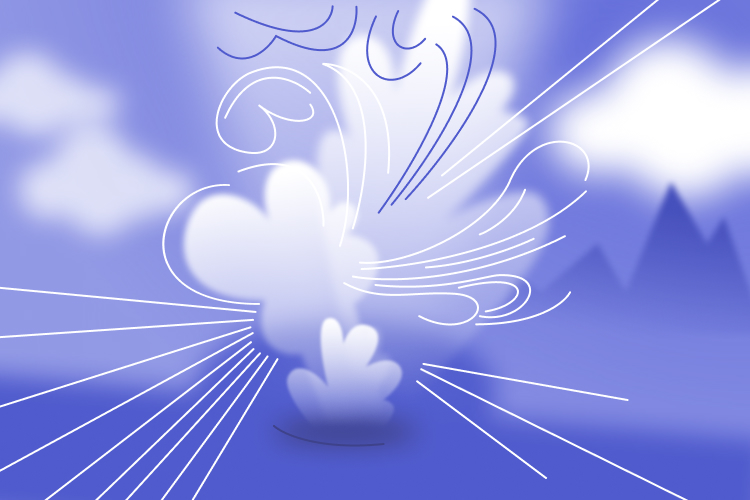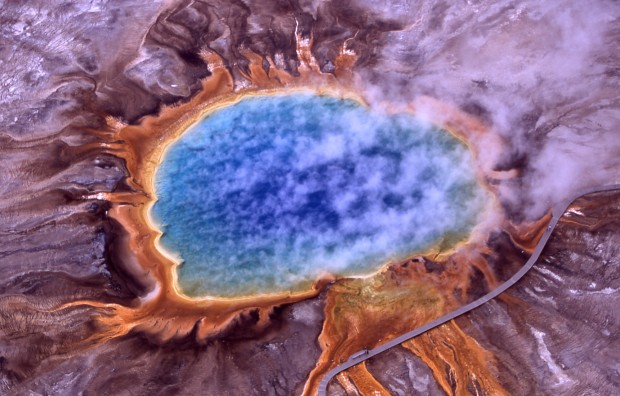Atom Interferometry
Physicist David Pritchard on source of coherent atoms, measuring polarization, and precision inertial navigati...

Geysers are features that erupt liquid water and steam at boiling temperatures. And, by definition, things we call geysers erupt either periodically or episodically. The difference is that periodically means regularly. Episodically means that the time between eruptions is not always the same. There are also many other ways of classifying geysers. There are geysers that are small and some that are big. There are cold geysers that erupt a mixture of liquid water and carbon dioxide gas. In general, geysers are not common. There were once about 1000 worldwide, but now there are about 500 left. They disappear because areas that have geysers have geothermal resources. And because of climate change, geothermal energy is being used more and more. Once you start extracting fluids to power a geothermal plant, the geysers lose their energy source and water source. And if you keep doing this for long enough, all of the geysers might disappear.
There are three reasons why it’s important to study geysers. First, geysers are a model for how volcanoes erupt. And we care about how they erupt, what initiates the eruption, how everything rises to the surface, and how it gets transported in the atmosphere. Volcanoes are big and dangerous, and they don’t erupt very often. Geysers are small and much less dangerous, and they erupt many times. And one of the things we hope to learn from geysers is how to understand and model eruptions more generally. We can also deploy a range of geophysical instruments at geysers. We can use seismometers to measure ground motion, we can measure electric and magnetic fields, we can take videos, and we can try and integrate all these different types of measurements to understand what happens during an eruption. And then, we can try to transfer this understanding from small geysers to big volcanoes.
The second reason that we care about geysers is that they are a window into how the Earth transports hot water. There are features called geothermal systems which we use for geothermal energy, and geothermal systems make materials like gold deposits. By transporting hot fluids, you can transport all of the elements that dissolve in water. And when we look at a geyser, we get a window into how the Earth is transporting a mixture of steam and water.
And the third reason is that they are interesting, fascinating natural phenomena. If we understand how the Earth transports fluids and energy, we should be able to explain how geysers work. And the extent to which we can’t do so tells us that there are basic things about the heat transport of the Earth that we don’t know yet.
The first modern scientific study of geysers was done by Bunsen, who is best known to most people as the Bunsen burner inventor. And the Bunsen burner is the little burner you use in class. His biggest contribution was leading to the discovery and invention of spectroscopy. In 1841 he published a paper regarding measurements he made inside a geyser in Iceland, and those measurements are still relevant today.

One of the key questions is why is it that a geyser erupts? And you could imagine several ways it might erupt. It could erupt starting at the top of the geyser or maybe at the bottom of the geyser. Bunsen made measurements of temperature as you go deeper inside a geyser, boiling water at different temperatures. In 1841 it must not have been very easy. And in fact, he made these measurements at the geyser called Geysir, after which geysers get their name. So there’s a real feature called Geysir in Iceland, and all geysers are named after that one.
What Bunsen found is that if you go deeper below the surface, the temperature of the water goes up. And it’s an important feature of the boiling of water that if the pressure goes up, the boiling temperature goes up. So if you take the water off a certain temperature from deep inside the geyser and lift it closer to the surface, the pressure is lower. As you go deeper, the pressure gets higher. And the converse is true as well. If you go from a higher depth to a lower depth, the boiling temperature goes down.
So you start with water that’s hot, you bring it to low pressure, it crosses over that boiling temperature, the water boils, and you initiate an eruption. And if you keep taking water out of the geyser, all the rest of the water experiences lower and lower pressures, and the eruption continues. And presumably, this happens until you run out of water. Then you fill up the geyser again, and you heat it up. You can think about this as what, in some other areas of science, we call decompression boiling. This is actually the primary way that the Earth makes volcanic rocks. You take rocks at high pressure, bring them to low pressure, and they melt. So geysers may work the same way. And Bunsen measured and proposed this back in 1841.
In principle, in areas with lots of geysers, geysers must be born. In fact, they have to be born because some of them die. We don’t really understand well what it takes to make a brand-new geyser. There’s been some speculation that they begin with big explosions. If you accumulate steam and water underground, you can get an explosion called a hydrothermal explosion, and they do happen in places like Yellowstone. The importance of an explosion is that it makes a hole or a cavity. And to make a geyser, it seems that you need some kind of cavity to accumulate steam and hot water.

In a laboratory, however, scientists can make geysers without a big cavity. In fact, scientists have been making geysers in the laboratory for over a hundred years. The way that they do it is pretty simple: all it takes is heat and water. So scientists take a container of water, heat it from below, and eventually, the water boils. The boiling propagates through the geyser and there’s an eruption. When the steam or the heat runs out, the eruption ends.
The point of studying geysers in a laboratory is that you can try to understand how different variables affect the eruption. There are many variables you might consider. How big the heating range is, what the geometry is, what happens if you have a fat tube or a skinny tube, or whether, if you have two tubes, they intersect or not. This provides a way of understanding how heat and mass are transported in a hot system. Thus laboratory experiments can be used to better understand natural geysers.
There are only a few places on Earth where you can find geysers. There’s Yellowstone National Park, which has about half of them, Geyser Valley in Kamchatka, the El Tatio Geyser Field in Chile, New Zealand; there are some in Africa, and then a few in Iceland. And they all share three common features.
The first is recent volcanic activity. That’s important – you need heat. If you don’t have heat, which is provided by young volcanoes, it’s hard to have geysers. Secondly, most of these areas had glaciers covering them recently. That may be important to create the right kind of materials in which you can have the plumbing system that feeds geysers. And you also need water. Most of the places I mentioned have access to lots of water, except for Chile, which is the Atacama desert. There the water is probably coming from deep underground aquifers and then creating the geysers.
A pool geyser basically has a reservoir of water on the surface, and the geyser erupts through that pool. Pool geysers seem to be very sensitive to air temperature. There is a geyser in Yellowstone called the Daisy geyser, and in the winter, it erupts less often than it does in the summertime. It’s also sensitive to the wind: if the wind blows faster, then the pool cools, and it takes longer for the eruption. So as the Earth gets warmer, geyser eruptions should actually become more frequent.
Geyser research is conducted all over the world, but many of our outstanding questions about geysers need measurements from inside a geyser to answer them. In the US national parks, scientists are not allowed to put measurements inside a geyser or even that close to one. There’s always some potential that you might damage or alter the geyser in some way, and the objective of the National Parks is to preserve and protect the natural environment for everyone to appreciate.
Almost all places with geysers are National Parks, so scientists have worked out an arrangement with the native communities that manage the geysers in Chile. They’ve been allowed to take certain types of non-destructive measurements as long as they don’t damage the geysers in any way. But this arrangement allows scientists to measure temperature and pressure inside a geyser and also sample fluids and give them more detailed monitoring than would be possible elsewhere.
There’s a set of geysers in Chile that is particularly interesting. There’s one geyser called El Jefe in Chile. El Jefe is Spanish for “the Boss,” and El Jefe is a beautiful geyser. It’s a very small geyser which erupts to a height of a couple of meters, so just a little taller than a person. Because it’s small, it’s especially easy to study, and El Jefe is one of the most regular geysers in the world. It erupts every 140 seconds, plus or minus 1 second, so it’s perfectly regular. It doesn’t matter if it’s +20⁰ C outside, or -10⁰, whether it’s windy or not. And because it’s so regular we can do experiments on the geyser. We can take measurements inside or add a bit of cold water to see how long the geyser takes to recover. It’s a perfect example of a model system that we can use to understand basic processes.
Another observation is that we have been able to measure the speed at which water is moving inside geysers, and based on what we’ve been able to study, it does look like they erupt at the speed of sound. So the hypothesis that fluids erupt at the speed of sound might be something that we are actually able to measure and test. So some progress has been made in understanding what the subsurface geometry is like and why they are erupting. Now it’s important to figure out whether these new findings are general or whether there’s something special or unusual about the particular geysers that have been studied. And this brings us to the many open questions that still remain.
There are many basic questions that we still don’t know the answers to. First, why do geysers exist? Why aren’t they hot springs? Do eruptions begin at the top of the geyser, or does something happen deeper inside the geyser? What causes the eruption to end? Is there something special about the subsurface that allows a geyser to form? Before the main eruptions of geysers, sometimes there are small minor eruptions, and we’d like to understand whether this is how geysers get ready to erupt or whether it’s just a smaller eruption. We’d like to understand how much mass and energy geysers transport to the surface and how and why they erupt to external influences.
What does that mean? Earth has tides, and tides cause the Earth to squish and unsquish and deform, and that might affect eruptions. Changes in the weather can affect eruptions, and distant earthquakes can affect eruptions. So we’d like to understand what it is about these external influences on geysers that make them change how they work. We’d also like to know how fast material erupts from the geyser. In our models for volcanoes, we often assume that they erupt at the speed of sound, and in geysers, we can test that model. Given how much has been learned from recent measurements, there is every chance that many of these open questions will be answered.
Edited by Alina Shubina

Physicist David Pritchard on source of coherent atoms, measuring polarization, and precision inertial navigati...

Phycisist John Doyle on travelling salesman problem, electric dipole moment, and laser cooling

Glaciologist Martin Siegert on the history of glacial theory, lake Vostok research and what ice tells us about...